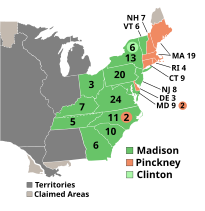
Back انتخابات الرئاسة الأمريكية 1808 Arabic ھەڵبژاردنی سەرۆکایەتیی ویلایەتە یەکگرتووەکانی ئەمریکا (١٨٠٨) CKB Volby prezidenta USA 1808 Czech Præsidentvalget i USA 1808 Danish Präsidentschaftswahl in den Vereinigten Staaten 1808 German Elecciones presidenciales de Estados Unidos de 1808 Spanish انتخابات ریاستجمهوری ایالات متحده آمریکا (۱۸۰۸) Persian Yhdysvaltain presidentinvaalit 1808 Finnish Élection présidentielle américaine de 1808 French הבחירות לנשיאות ארצות הברית 1808 HE
| |||||||||||||||||||||||||||||
176 members of the Electoral College 89 electoral votes needed to win | |||||||||||||||||||||||||||||
|---|---|---|---|---|---|---|---|---|---|---|---|---|---|---|---|---|---|---|---|---|---|---|---|---|---|---|---|---|---|
| Turnout | 36.8%[1] | ||||||||||||||||||||||||||||
| |||||||||||||||||||||||||||||
 Presidential election results map. Green denotes states won by Madison, Salmon denotes states won by Pinckney, and Light Green denotes states won by Clinton. Numbers indicate the number of electoral votes cast by each state. | |||||||||||||||||||||||||||||
| |||||||||||||||||||||||||||||
Presidential elections were held in the United States from November 4 to December 7, 1808. The Democratic-Republican candidate James Madison defeated Federalist candidate Charles Cotesworth Pinckney decisively.
Madison had served as Secretary of State since President Thomas Jefferson took office in 1801. Jefferson, who had declined to run for a third term, threw his strong support behind Madison, a fellow Virginian. Sitting Vice President George Clinton and former Ambassador James Monroe both challenged Madison for leadership of the party, but Madison won his party's nomination and Clinton was renominated as vice president. The Federalists chose to re-nominate Pinckney, a former ambassador who had served as the party's 1804 nominee, again alongside Rufus King.
Despite the unpopularity of the Embargo Act of 1807, Madison won the vast majority of electoral votes outside of the Federalist stronghold of New England. Clinton received six electoral votes for president from his home state of New York. This election was the first of two instances in American history in which a new president was selected but the incumbent vice president won re-election, the other being in 1828.
- ^ "National General Election VEP Turnout Rates, 1789-Present". United States Election Project. CQ Press. Archived from the original on November 14, 2016.

